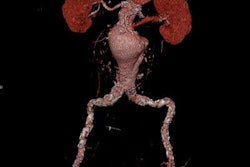
Mortality from abdominal aortic aneurysms (AAAs) has dropped sharply over the past two decades, thanks to lower smoking rates -- and this trend is reducing the value of ultrasound AAA screening programs, according to a large Swedish study published in Lancet.
Researchers led by Dr. Minna Johansson of the University of Gothenburg found a small improvement in mortality from AAA between a group of men who received screening and a control group who did not receive screening, but the increase was deemed statistically insignificant. What's more, ultrasound screening was associated with significant harm from overdiagnosis and unnecessary treatment (Lancet, 13 June 2018).
"The small benefit and substantially less favorable benefit-to-harm balance call the continued justification of the intervention into question," the authors wrote.
They also noted that many cases of AAA were identified outside of the screening program, through opportunistic testing and identification.
To estimate the effects of organized AAA screening in Sweden, the researchers followed 25,265 men ages 65 or older who were invited to receive AAA screening between 2006 and 2009, as well as a matched control group of 106,087 men with similar characteristics but who were not invited for screening. They then calculated how many men were diagnosed with an AAA, how many received surgery, and how many died from AAA. In addition, they studied overall trends for these factors for all men ages 40 to 99 in Sweden between 1985 and 2015.
Between 2000 and 2015, mortality from abdominal aortic aneurysms dropped from 36 deaths per 100,000 men ages 65 to 74 to 10 deaths per 100,000 men, a decline of 70%. However, mortality rates remained similar in men who were and weren't screened. An estimated two deaths were avoided for every 10,000 men six years after screening, but that difference wasn't statistically significant, according to the researchers.
Johansson and colleagues did find, though, that screening was associated with significant harm from overdiagnosis and unnecessary treatment. Of those men who received screening, 49 in 10,000 were likely to have been overdiagnosed and 19 of these were likely to have undergone surgery they didn't need.
Prior to this study, the balance between the benefits and harms of AAA screening programs was unclear as the major harms had not been adequately considered, according to Johansson. The authors noted that smoking rates in Sweden fell from 44% to 15% between 1970 and 2010.
"Our new findings suggest that this screening program may be outdated, because the number of deaths from abdominal aortic aneurysm has been greatly reduced, likely due to lower smoking rates," Johansson said in a statement. "As a result, the harms of this screening appear to outweigh the benefits, and our findings question the continued use of screening for abdominal aortic aneurysm in men. The results from this study are likely to be applicable to countries with similar trends in smoking rates and abdominal aortic aneurysm, which applies to many Western countries, for example the U.K."



















